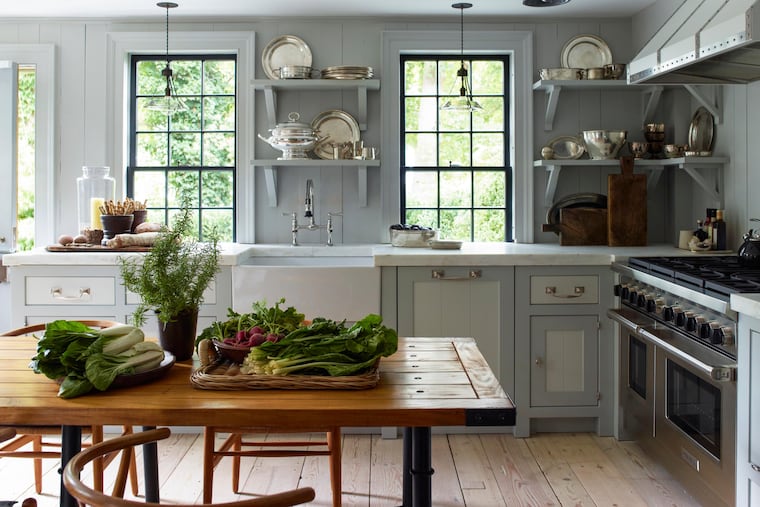Move over, islands, kitchen tables are making a comeback
“A table has a domestic warmth to it that an island doesn’t,” a New York interior designer says. "When an island is built-in and matches the cabinets, it has a stiff, immobile presence.”

Growing up, there was only one place to be after every holiday meal: my grandma’s kitchen table. It was a hub of activity and chatter that went far beyond who should get the last slice of pie. Stories were swapped; highballs were drank; cards were played. If a piece of furniture could evoke a sense of family and community, the table was it.
Lately, a handful of designers and taste-makers are embracing the old-fashioned table as a homier alternative to the ubiquitous island. Cabinetry companies such as deVol Kitchens and Plain English have launched U.S. showrooms to an overwhelmingly positive response in the last year, and their advertising often features images of kitchens with tables front and center. The spaces present a cozy and inviting antidote to overly sleek kitchens with tricked-out islands.
“A table has a domestic warmth to it that an island doesn’t,” New York interior designer Steven Gambrel says. "When an island is built-in and matches the cabinets, it has a stiff, immobile presence.”
For Helen Parker, creative director of deVol, adding a vintage table is a way to create a more authentic, eclectic vibe. “All of those matching parts don’t feel as soulful as when you have a great big table with a bunch of flowers where the kids can do their homework,” she says.
Gambrel also cites lightness as a part of a table’s appeal. “It feels more airy and less contrived than an island, which can feel bulky and dated,” he says.
Part of the problem, in Parker’s opinion, is the temptation for homeowners to fit everything — and literally the kitchen sink — into an island. “It’s become a big box with too many appliances, stools, and a garbage bin; it ends up not being an aesthetically pleasing piece of furniture,” she says.
But the fully loaded island has a tight grip on America’s imagination. A recent Houzz survey estimated that 38% of kitchen remodels involved adding an island (and that doesn’t include all of the homes that already have one). Some trend forecasters even predict that we’ll see a future rise in the popularity of double islands.
According to Home Advisor, the cost of a kitchen island averages $3,000 to $5,000, though custom-built options can be $10,000 or more. Of course, not every kitchen can accommodate a built-in island. For older houses with small or galley-style cook spaces, planning for an island involves opening up a wall or bumping out the back, which can increase renovation costs dramatically.
In those situations, a small- to medium-size table can be a practical and affordable solution, offering comparable prep space. A solid pine table from Ikea will set you back just $99, while an antiqued elm one with a distressed metal base from Restoration Hardware starts at $1,095.
The earliest islands were humble worktables in the center of the kitchen (think downstairs at Downton Abbey). The open kitchen and built-in island didn’t arrive until the 20th century.
“The iconic suburban image of the command-post kitchen where the woman of the house could do her work and observe the kids really resonated in 1950s America,” says Sarah Leavitt, curator at the National Building Museum in Washington. “The idea was to build this concept of family and togetherness right into the actual architecture and design of the house.”
While the island was an aspirational symbol of modern housekeeping, it was mostly a product of postwar construction of suburban single-family homes. It gained momentum through the 1960s and ’70s but didn’t become a mainstream design element until the 1980s and ’90s, when open-plan kitchens became the rage, buoyed by the popularity of the Food Network and HGTV.
Suddenly, the island wasn’t just a prep space but also a stage to perform for your guests, though visibility has its drawbacks. “It looks nice when it’s clean," Leavitt says, "but given the potential for mess, it’s surprising that it continues to have widespread appeal.”
One irony of the island is that it's come to epitomize casual living, yet bellying up to one isn't always easy or comfortable. A counter-height stool often lacks adequate support for longer stretches of sitting. "There's just something nicer about relaxing into a proper chair and being able to spread out at a table," Parker says.
Another downside: Breakfast bar-style seating often forces everyone to eat facing the same direction — fine for a quick bite on-the-go, but not exactly great for connecting with one another.
“It’s a question of, ‘Why does one thing feel good and not the other?’ And it comes down to being honest about the way we actually live vs. the way we think we should live,” Gambrel says. “When you experience an easy house where someone likes to cook and entertain, and they serve you coffee at the table and there’s music playing, it resonates with you; naturally, you’d want to emulate that.”